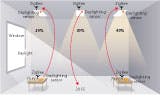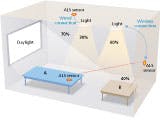This article was published in the Winter 2013 issue of IIF Magazine.
View the Table of Contents and download the PDF file of the complete Winter 2013 issue, or view the E-zine version in your browser.
+++++
Environmental sustainability has become an increasingly important consideration in building design, construction, and maintenance in recent years. According to the US Department of Energy, worldwide energy consumption will increase approximately 40% by 2035. Lighting is a major consumer of energy, but cognitive lighting combining intelligence, sensors, and energy-efficient sources can actually reduce the amount of energy spent on lighting.
The looming energy crisis has garnered the attention of governments around the world, who are increasingly implementing mandates to ensure the reduction of energy consumption and related greenhouse gas emissions. Additionally, utility companies in the US offer rebates and incentive programs for high-efficiency retrofits and new installations.
Cutting energy use can take a bite out of a building’s maintenance and upkeep budget, which makes up approximately 80% percent of the overall lifetime cost of the average building, according to some estimates. But how do building owners and facility managers change their current lighting systems? Is there a way to make the light so intelligent that, in essence, it becomes similar to the human eye and adjusts according to the many light sources – and people – in a room?
This is where cognitive lighting comes into play. It’s a unique approach that focuses on the light, not on the power supply. The coming wave of cognitive lighting will demand independent smart sensors that are environmentally aware in order to provide not simply data on the surrounding environment, but answers on how best to respond, both to save energy and enhance lighting quality.Cognitive lighting
Just what do we mean by cognitive lighting? Lighting fixtures and systems available today are relatively un-intelligent and require user input to adjust light levels to specific requirements. Unfortunately, this means keeping the lights on most of the time and at the lights’ highest intensity – irrespective if this is needed.
However, sensor-driven lighting that is easy-to-use is key to adopting more optimized and energy efficient lighting. Ambient light sensors combining photopic, human-like sensitivity with wide dynamic range are enabling a new generation of lighting controls that may be built directly into replacement lamps and luminaires to shift more of the interior lighting burden onto the available daylight.
In a facility with skylights, windows, or sidelights, the available daylight varies according to time of day and weather conditions, for example (Fig. 1). Areas that get light from those sources don’t necessarily need much artificial light – at least not during the day – but areas farther from those sources do. The problem is in a large site with thousands of square meters of space. In this case, managing each fixture’s light output to compensate for the changing amounts of ambient light during the day is an enormous challenge and impossible to do manually.
Some facility managers take advantage of daylight by using external daylight harvesting sensors that attach to groups of lights. These after-market offerings can provide incremental energy reductions, but still leave substantial savings on the table and have a number of performance issues that result in over- or under-lit areas and jarring jumps or drops in light levels.
The integrated sensor A sensor built into the luminaire that automatically responds to its environment – whether it’s concerning occupancy, available daylight, time of day, or other variables – and delivers just the right amount of light when and where it is needed is the perfect solution for reducing energy consumption and costs. Moreover, new silicon sensors from companies such as ams closely mimic the eye response (Fig. 2).Rather than applying controls as an afterthought, this built-in approach maximizes energy efficiency.
With simple-to-use remote control systems to change the target light levels, the facility manager doesn’t need to get up on a lift and adjust dipswitches on sensors controlling 100+ fixtures. The manager also doesn’t need to turn them off in an unused part of the facility, dim them 10 percent in another room, and do nothing in an area that should not be touched. By supplementing the working space with only the amount of light needed to maintain a uniformly lit environment, tremendous energy savings can be realized when compared to existing installations that do not respond to changes in ambient light.
Putting light where the eye is and providing local control means that more light isn’t always needed or wanted. Smarter lighting controls can save more than 50% on energy, while providing adequate lighting (Fig. 3).
Starting with the light The key to developing new user friendly lighting systems is to design them from the standpoint of light and not the power supply – from where most of today’s lighting is driven. System-on-chip light sensor solutions provide a complete light sensing subsystem, including conversion of analog readings to digital data that can be transmitted over common microprocessor interfaces. This includes correction for any errors caused by light flicker, on an integrated circuit as small as 2-mm square, and is not cost prohibitive. Additionally, sophisticated filtering automatically rejects the 50-60 Hz ripple typically produced by a building’s fluorescent lighting systems, enabling the sensed light levels to more accurately measure the daylight that is entering the building.Being fully aware of the lit environment has benefits that extend beyond energy savings. In integrated building management and control systems, the combination of proximity/motion and light sensing provides an abundance of data concerning the interior environment. Additionally, daylight sensing/harvesting combined with precise control mechanisms enable the lighting system to deliver not just the needed amount of light, but also offers the ability to tune the type of light to suit the activity and users in a particular space.
Intelligent lighting market drivers
A recent report by Pike Research, “Intelligent Lighting Controls for Commercial Buildings,” outlines market drivers for lighting controls, which are primarily through government energy reduction mandates:
• In the US, the market for lighting controls in construction projects will be driven by a new federal requirement that all states adopt building codes that are at least as stringent as the most recent American Society of Heating, Refrigeration and Air Conditioning Engineers (ASHRAE) building code (90.1-2010) by October 2013. That code requires automatic shutoff and dimming in many space applications and will encourage numerous construction projects to go further and connect lighting systems to building management systems.
• European 2020 energy targets will drive adoption of lighting controls among EU member states. All new public buildings must have net-zero energy consumption by 2019 and private buildings must follow suit two years later. Intelligent lighting controls will be a must to meet this strict target.
• China’s 12th Five-Year Plan (2011-2015) sets strong targets for energy efficiency projects, including the city-wide control of street lighting that is already ramping up. A similar expansion to building lighting control is expected.
Non-visual effects of light
We should also consider the non-visual effects of light on humans when discussing cognitive lighting. Most commercial buildings are illuminated by fluorescent fixtures that provide artificial lighting with a spectrum incompatible with natural light. New research in the area of color science and health shows that human health, well being, and productivity can be improved through the use of natural lighting. The research also conclude that people who spend more time in natural light rather than in artificial light have increased productivity and alertness.
There is evidence that there are two separate functional pathways that carry information about light to the brain. The non-visual pathway leads to the hypothalamus, the coordinator of many functions, including the release of many hormones. Melatonin is among the best known of these; it is the chemical signal that regulates circadian rhythms and keeps them in synch with environmental light. Melatonin is secreted in darkness and suppressed by bright light.
Light serves to synchronize the human body bio-chemical clock. For instance, we have found that blue light (465-nm wavelength) can reduce the melatonin in our blood stream, making us more alert – this is what sunlight produces from morning until afternoon. However, as evening progresses, the intensity of the blue light in sunlight reduces with the increase in reds and purples, thus enabling the increase in melatonin that enables sleep and body repair. The effect of light on melatonin, alertness, and cognitive performance is blue-shifted — a lamp with 6500K (cold light) induces greater melatonin suppression and an enhanced alerting effect than a lamp with 2500K (warm light).
Light directly influences the amount of melatonin a person’s brain produces, which indirectly affects alertness. With lower melatonin, it’s not just sleep that is affected; almost our entire metabolism, including immune responses, is regulated in this way, and there is the potential for more serious health effects.
Today’s office lighting is constant with a high blue-shifted content, keeping workers awake and alert, but impacting the sleep cycle for those who work late or focus on computer screens at home in the evening (computer screens and flat-panel TVs also deliver a high blue content).
LED lighting with tunable white light enables us to have healthy, natural light that can provide the required alertness with increased productivity in the daytime, while adapting the circadian rhythm to maintain healthy melatonin levels in the evening for better health and performance.
Environmentally-aware, decision-directed, multi-sensor networks and optimized light will enhance not only the productivity of the built space, but also worker and group productivity, as well as increasing the health and wellbeing of individuals.
A smart-sensor driven lighting system that is aware of the immediate environment and broader operating concerns and is able to intelligently adapt to user and facility requirements with autonomous local- or centralized-control is critical to meet worldwide government mandates to reduce energy consumption and lessen greenhouse gas emissions. This next wave of cognitive lighting systems will finally make use of the abundance of data available in the light and autonomously adjust the built environment to enhance comfort, productivity, safety and efficiency at the same time.
The demand for power around the world continues to increase. It’s essential, therefore, to have light fixtures that reduce consumption. Currently, all sensors and daylight harvesting systems are driven by controls and power rather than using light as the starting point. However, looking at light differently and understanding that the future of lighting must be fully adaptive is the only way to truly lower energy consumption and costs.









